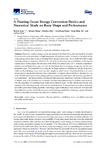A Floating Ocean Energy Conversion Device and Numerical Study on Buoy Shape and Performance
| dc.contributor.author | Song, R | |
| dc.contributor.author | Zhang, M | |
| dc.contributor.author | Qian, X | |
| dc.contributor.author | Wang, X | |
| dc.contributor.author | Dai, Yong Ming | |
| dc.contributor.author | Chen, J | |
| dc.date.accessioned | 2016-08-05T09:52:00Z | |
| dc.date.available | 2016-08-05T09:52:00Z | |
| dc.date.issued | 2016-06 | |
| dc.identifier.issn | 2077-1312 | |
| dc.identifier.issn | 2077-1312 | |
| dc.identifier.other | ARTN 35 | |
| dc.identifier.uri | http://hdl.handle.net/10026.1/5192 | |
| dc.description.abstract |
Wave and current energy can be harnessed in the East China Sea and South China Sea; however, both areas are subject to high frequencies of typhoon events. To improve the safety of the ocean energy conversion device, a Floating Ocean Energy Conversion Device (FOECD) with a single mooring system is proposed, which can be towed to avoid severe ocean conditions or for regular maintenance. In this paper, the structure of the FOECD is introduced, and it includes a catamaran platform, an oscillating buoy part, a current turbine blade, hydraulic energy storage and an electrical generation part. The numerical study models the large catamaran platform as a single, large buoy, while the four floating buoys were modeled simply as small buoys. Theoretical models on wave energy power capture and efficiency were established. To improve the suitability of the buoy for use in the FOECD and its power harvesting capability, a numerical simulation of the four buoy geometries was undertaken. The shape profiles examined in this paper are cylindrical, turbinate (V-shaped and U-shaped cone with cylinder), and combined cylinder-hemisphere buoys. Simulation results reveal that the suitability of a turbinate buoy is the best of the four types. Further simulation models were carried out by adjusting the tip radius of the turbinate buoy. Three performance criteria including suitability, power harvesting capability and energy capture efficiency were analyzed. It reveals that the turbinate buoy has almost the same power harvesting capabilities and energy capture efficiency, while its suitability is far better than that of a cylindrical buoy. | |
| dc.format.extent | 35-35 | |
| dc.language | en | |
| dc.language.iso | en | |
| dc.publisher | MDPI AG | |
| dc.subject | ocean energy conversion | |
| dc.subject | floating platform | |
| dc.subject | oscillating buoy | |
| dc.subject | simulation analysis | |
| dc.subject | suitability performance | |
| dc.title | A Floating Ocean Energy Conversion Device and Numerical Study on Buoy Shape and Performance | |
| dc.type | journal-article | |
| dc.type | Journal Article | |
| plymouth.author-url | https://www.webofscience.com/api/gateway?GWVersion=2&SrcApp=PARTNER_APP&SrcAuth=LinksAMR&KeyUT=WOS:000443615700007&DestLinkType=FullRecord&DestApp=ALL_WOS&UsrCustomerID=11bb513d99f797142bcfeffcc58ea008 | |
| plymouth.issue | 2 | |
| plymouth.volume | 4 | |
| plymouth.publication-status | Published | |
| plymouth.journal | Journal of Marine Science and Engineering | |
| dc.identifier.doi | 10.3390/jmse4020035 | |
| plymouth.organisational-group | /Plymouth | |
| plymouth.organisational-group | /Plymouth/Faculty of Science and Engineering | |
| plymouth.organisational-group | /Plymouth/Faculty of Science and Engineering/School of Engineering, Computing and Mathematics | |
| plymouth.organisational-group | /Plymouth/PRIMaRE Publications | |
| plymouth.organisational-group | /Plymouth/REF 2021 Researchers by UoA | |
| plymouth.organisational-group | /Plymouth/REF 2021 Researchers by UoA/UoA12 Engineering | |
| plymouth.organisational-group | /Plymouth/Research Groups | |
| plymouth.organisational-group | /Plymouth/Research Groups/Marine Institute | |
| plymouth.organisational-group | /Plymouth/Users by role | |
| plymouth.organisational-group | /Plymouth/Users by role/Academics | |
| dc.contributor.advisor | ||
| dcterms.dateAccepted | 2016-04-25 | |
| dc.identifier.eissn | 2077-1312 | |
| dc.rights.embargoperiod | Not known | |
| rioxxterms.versionofrecord | 10.3390/jmse4020035 | |
| rioxxterms.licenseref.uri | http://www.rioxx.net/licenses/all-rights-reserved | |
| rioxxterms.licenseref.startdate | 2016-06 | |
| rioxxterms.type | Journal Article/Review | |
| plymouth.oa-location | http://www.mdpi.com/2077-1312/4/2/35 |


